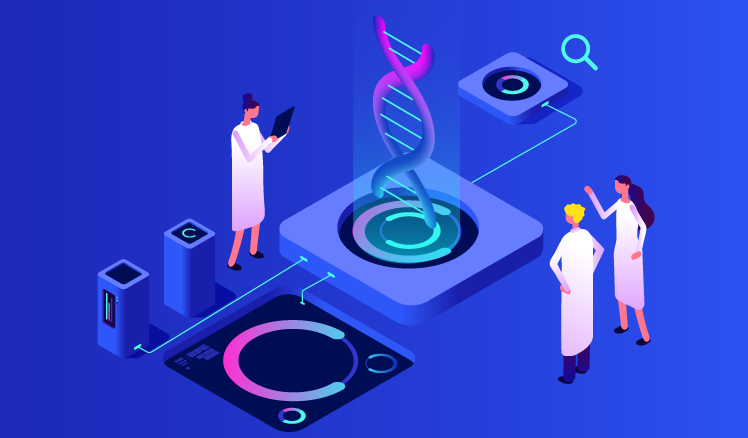Cancer and AI-based image analysis: A revolutionary way to detect, predict, and treat DNA mutations
After decades of trying to find drug-based cancer treatment, doctors now hope that technology will help to both diagnose and treat cancer. Many cancer detection and treatment methods, which could help to save lives even under the bleakest outlooks, appeared thanks to the advance in the artificial intelligence (AI) and medical image analysis fields. Let’s take a closer look at what changes these technologies can bring to the battle against cancer.

Image analysis for fast and accurate cancer detection
When it comes to aggressive forms of cancer, scientists and researchers realize the imperative nature of a swift diagnosis. Many cancers, such as the lung cancer mesothelioma, are often misdiagnosed or detected too late, leaving patients with little to no choice in treatment options and short life expectancies With AI in the picture, doctors are looking forward to faster cancer detection.
Researchers in Germany, France, and the United States already revealed that, when detecting cancer, AI technology is more accurate than a doctor’s eye. Their studies showed that AI-based image analysis software can detect cancer in 95% of images of cancerous moles and benign spots. In comparison, doctors were able to correctly detect cancer only in 87% of the exact same pictures.
AI systems and the Collaborative Cancer Cloud
Many research companies that don’t have medical partnerships and, hence, access to patient data, are forced to train their AI systems on fabricated patient records. This hampers the evolution of AI algorithms that assist in disease detection, diagnosis, and treatment, since work with real patient data is crucial for their growth. IBM named the lack of real-world data the main reason why their Watson AI provided incorrect treatment recommendations.
The Collaborative Cancer Cloud (CCC) can resolve this issue, as all cancer patients’ information can now be added to this safe and encrypted cloud-based system developed by Intel. The data in the CCC is useful for the training of new AI systems as well as for the work of already mature AI software. In the latter case, it can reduce the time expenses for cancer detection, diagnosis, and treatment planning to a mere 24 hours. For example, AI can be asked to compare the newly diagnosed patient data against a vast amount of older patients’ data in the CCC. Once the analysis is complete, doctors will get precise information about the type of a new patient’s DNA mutations and the way these mutations were previously treated.
AI-based DNA pattern analysis
The Institute of Cancer Research London (ICR) developed a new technique called the Repeated Evolution of Cancer, also known as the Revolver. According to this method, an AI system picks a mutated DNA pattern within cancer cells and uses that information to predict further genetic changes. Moreover, the ICR research team found a link between certain DNA sequences and treatment outcomes. This suggests that DNA patterns of treated cancer patients can be used to give a more accurate prognosis to recently diagnosed patients.
Dr. Andrea Sottotiva, who led the ICR study, said that AI is a revolutionary tool to perform fast and accurate image analysis and comparison of DNA patterns. She hopes that this tool helps healthcare providers predict the ever-changing illness and work more effectively with patients before cancer cells become drug resistant.
Inception v3
Inception v3 by Google is an example of AI-based image analysis software that works with DNA and cancer data. Google’s system has an open-source algorithm, trained to identify 1,000 different classes of objects. As part of the training, developers used thousands of images of both healthy and cancerous tissues from The Cancer Genome Atlas. Thanks to a sophisticated subset of machine learning called ‘deep learning’, the software was able to advance on its own and learn the difference between the two types of tissues as well as different types of cancer cells.
Aristotelis Tsirigos, a pathologist at NYU School of Medicine and a lead author on a study of AI and cancer, stated that Inception v3 can also find mutations inside the DNA of cancer cells, helping doctors discover mutations and get ahead of the disease with appropriate treatment. He said, “These cancer-driving mutations appear to have microscopic effects that the algorithm can detect.”
Google’s system is so advanced, that it is continuously learning inside its own “black box”, without human interference. Neither programmers nor doctors know how exactly it makes specific discoveries. This is something that worries the medical field: after all, machines can make mistakes, and if creators don’t know how the algorithms work, they will be unable to find and prevent miscalculations. However, specialists at Cornell say that with Inception v3’s 99% accuracy, the risk is worth the reward.
The Future
Artificial intelligence and image analysis can help healthcare professionals to provide cancer patients with more treatment options. A recent survey showed that 60% of Americans would be open to genetic testing to determine their risk for developing cancer, while 44% of respondents would trust AI to make a cancer diagnosis and offer treatment recommendations. It is obvious, that patients are already open to new approaches.
A report by Signify Research also states that hospitals are expected to spend $2 million annually on AI for medical imaging devices by 2023. Additionally, according to Azati Software, an AI medical system can cost between $35,000 and $100,000 on average. However, even though the costs of the initial equipment may be high, a study by ABI Research of June 2018 estimated that AI applications can help the global healthcare sector save up to $52 billion by 2021.

